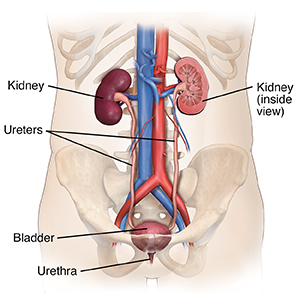What is cancer?
Cancer is when cells in the body change and grow out of control. To help you understand what happens when you have cancer, let’s look at how your body works normally. Your body is made up of tiny building blocks called cells. Normal cells grow when your body needs them. They die when your body does not need them any longer.
Cancer is made up of abnormal cells that grow even though your body doesn’t need them. In most cancers, the abnormal cells grow to form a lump or mass called a tumor. If cancer cells are in the body long enough, they can grow into (invade) nearby areas. They can even spread to other parts of the body (metastasis).
What is kidney cancer?
Cancer that starts in kidney cells is called kidney or renal cancer.
Understanding the kidneys
The kidneys are 2 bean-shaped organs. Each is about the size of a bar of soap. They sit just below the rib cage, toward the middle of the back. There is 1 kidney on each side of the spine. The kidneys help filter waste and excess fluid from the blood. The liquid and waste are then sent as urine to the bladder through thin tubes (ureters). Urine then leaves the body through a tube called the urethra. The kidneys also help control blood pressure. And they help make sure there are enough red blood cells in the body.
When kidney cancer forms
A kidney is made up of many layers of cells. Kidney cancer can affect any one or all of these layers. The cancer can stop the kidneys from working normally. Kidney cancer may spread to other parts of the body. When cancer spreads, it’s called metastasis. The more cancer spreads (metastasizes), the harder it is to treat.
What are the different types of kidney cancer?
The main type of kidney cancer is called renal cell carcinoma (RCC). About 9 out of 10 kidney cancer tumors are this type. If you have this type of kidney cancer, you will usually have only 1 tumor in 1 kidney. But there may be more than 1 tumor in 1 kidney or in both kidneys. These may be large by the time they are diagnosed. But most cases of kidney cancer are found before the cancer has spread to other organs.
There are many different types of RCC. A healthcare provider called a pathologist identifies these types by looking at the cancer cells under a microscope. The types of RCC include:
-
Clear cell. This is the most common subtype of RCC. The cancer cells look pale or clear.
-
Papillary. This is the second most common type of RCC and most common type of non-clear cell RCC. This type of tumor has tiny, fingerlike growths.
-
Chromophobe. This is a rare form of RCC. The cells are pale and larger than other types of RCC.
-
Collecting duct. This is also a rare form of RCC. The cancer forms in cells of the collecting ducts or tubules.
-
Medullary. This is a rare and aggressive type of RCC that mostly occurs in young people of African descent with sickle-cell trait or disease.
-
Unclassified. This includes tumors that have cells from more than 1 type of cancer. It also includes tumors with cells that don’t fit into the other categories.
Other types of kidney cancer
Other less common types of kidney cancers include:
-
Transitional cell carcinoma. This is also known as urothelial carcinoma. It starts where the ureter and kidney meet. This area is called the renal pelvis. This type of kidney cancer can act and look like bladder cancer.
-
Wilms tumor. Also called nephroblastoma, this cancer most always occurs in children. It's very rare in adults.
-
Renal sarcoma. This is a very rare type of kidney cancer. It begins in the blood vessels and connective tissue around the kidneys.
Kidney tumors that aren’t cancer
There are several types of kidney tumors that are not cancer (benign). These include renal cell adenoma, renal oncocytoma, and angiomyolipoma. These types of tumors may still affect kidney function and can cause pain and other symptoms. But the cells often do not spread to other organs.
Talk with your healthcare provider
If you have questions about kidney cancer, talk with your healthcare provider. Your healthcare provider can help you understand more about this cancer.


